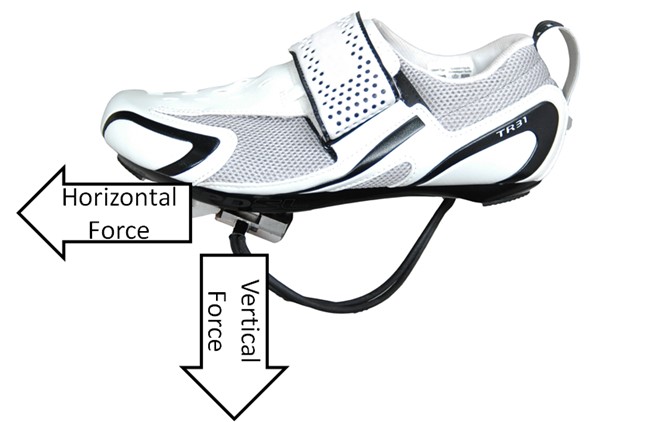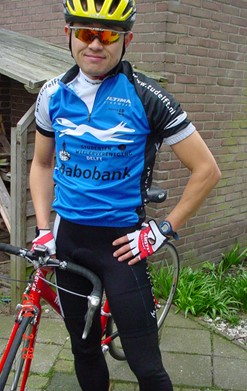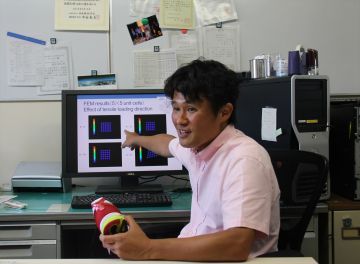TSUKUBA FUTURE
#028 From Sport to the Energy Industry—The Power of a Materials which Support Manufacturing
Associate Professor MATSUDA Akihiro, Faculty of Engineering, Information and Systems

The high-speed swimwear which first appeared at the Beijing Olympics in 2008 led to a slew of broken records which sent shockwaves around the world. This in turn changed the direction of competitive swimwear from reducing resistance to streamlining the shape of the body. These new swimsuits are made of firm but stretchy material woven using elastic manmade fibers created by coiling one strand of thread around another, like a spring. When worn, these swimsuits are greatly stretched and cling tightly to the body using the material's inherent recovery strength, thus streamlining the shape of the body. However, the fact that these swimsuits are designed to flatten any irregularities in the body means that they are certainly not very comfortable. Nonetheless, swimmers tolerate them because nothing is more important to them than improving their times and breaking records.
Prof. Matsuda conducts joint research with swimwear makers through 3D CG images of a swimmer using the front crawl technique and simulation of swimwear expansion, contraction, and inner stress.
Prof. Matsuda thinks that the material's inherent power may be able to support the actual action of swimming. When one tires during swimming, the legs lose buoyancy and one's speed drops. If the power of the swimsuit could be effectively harnessed to raise the swimmer's legs to the surface, then their endurance of the discomfort would pay off. On this point, in cooperation with swimwear manufacturers, skin movement during swimming was analyzed, the results of the analysis were combined with data of the elastic power of the swimwear, and the pressure of the swimwear on each part of the body during swimming was simulated. The pressure of the swimwear on the hip joint was calculated, and this enabled the team to determine the shapes of the constituent parts of the swimwear, seam angles, and other design aspects, to create a garment giving optimum support to the legs. Prof. Matsuda's research is creating an entirely new type of swimwear which will enhance the shape of the body and give the swimmer extra power.
Simulation of swimwear expansion, contraction, and inner stress through 3D CG images of a swimmer using the front crawl technique
Any material changes its shape if it is bent or pulled. This may be obvious, but it is also an important marker for expressing the special properties of a material. The science which investigates this is called material mechanics. The correlation between the force applied to the material and the changes in its shape is measured, this measurement data is used to create a simulation model which is used to calculate the effects of forces exerted on the material under various conditions. This requires complex mathematics, but once a model has been created it is possible to obtain simulation analysis results in a relatively short period of time. These results are verified by comparing them with actual measurement values, and are used as feedback in the development process.
It is possible to find ways of improving sporting motion using the same methodology. Bicycles are one example. Although it would seem that there is little difference in their pedalling form, some riders are faster than others even when they are all pedalling at the same pace. Where does this difference stem from? The force of the feet on the pedals was measured using sensors that detect changes in the shape of the pedals, and the extent, location, and direction of force on the pedals was recreated. It was discovered that experienced cyclists use the hip joints adeptly to ensure smooth and regular application of force on the pedals. On the other hand, beginners apply irregular force on the pedals through the knees and calves. From the force applied to the pedals it is possible to deduce which joints and muscles are used, and when they are used. The body is used in different ways for different actions, such as running and throwing, so the fact that a person is good at cycling does not necessarily mean that he or she is good at running. By the same token, even people who consider themselves to be completely non-athletic can in all likelihood find a type of exercise which is suited to them.

Prof. Matsuda, who was originally involved in research of polymers used in electrical power stations, is still continuing his energy industry-related research. He deals with a number of important themes in the field of basic safety and security, such as analysis of the effect of heat on electric cables during blazes, and development of flooring materials able to efficiently absorb the shock caused when heavy objects are dropped on them. Prof. Matsuda, who has always believed that material engineering is a discipline which must be developed in conjunction with human industry and culture, utilized the benefits of the comprehensive university and widened his fields of research to include sports science when he came to work at Tsukuba. Energy and sport are considered completely separate fields of research, but they are the same from the point of view of material transformations and the phenomena affected by them. It may sound extreme, but any material and any field could become the next focus of Prof. Matsuda's research.

The gallant figure of Prof. Matsuda taking part in a cycle race 10 years ago when he was working at Delft University of Technology in the Netherlands as a researcher. At present he is also an advisor to the Tsukuba University Cycling Club.

Shoe soles are also being researched.
Material mechanics is at the heart of manufacturing as the very base which determines material uses and product functionality. Prof. Matsuda has always believed in research which takes this classical discipline and applies it to actual product development and makes it useful for the world. He also has a number of joint research projects with corporations to develop materials and products. The fact that he can see people who will benefit from the research makes the research itself more rewarding. The innovative sports equipment developed by Prof. Matsuda will help make sporting events even more exciting?something to look out for in the future.
Article by Science Communicator at the Office of Public Relations


